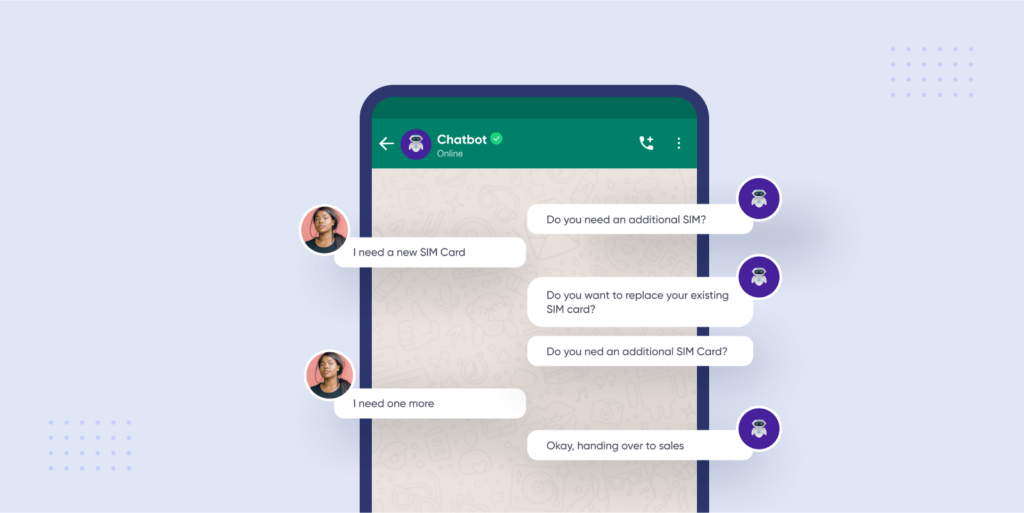
Engage, Convert, Empower: The Ultimate Guide to Ecommerce Chatbot
- July 2nd, 2025 / 7 Mins read
-
Aarti Nair
With exploding year-on-year growth in online shopping, customer expectations are soaring. Fortunately, advancements in AI, such as natural language processing, are helping retailers meet and exceed these expectations. One exciting innovation is the ecommerce chatbot: an AI-powered virtual assistant seamlessly integrated into websites, mobile apps, and social media platforms.
These chatbots provide 24/7 support throughout the buying journey, offering personalised assistance, answering FAQs, recommending products, tracking orders, and even suggesting discounts and gifts. By creating such a smooth and satisfying experience, eCommerce chatbots are boosting conversion rates and building customer loyalty.
And the market is taking notice! According to Statistica, the chatbot market is expected to reach 454.8 million U.S. dollars by 2027, signifying the immense potential of this technology.
Suggested reading: Everything You Need to Know About Conversational Commerce
Why are Ecommerce Chatbots Important?
Incorporating an ecommerce chatbot can yield a wide range of benefits. Let’s discuss some of them.
1. Increased customer satisfaction
Chatbot offers 24/7 customer support to cater to customer needs at their convenience. Even outside regular office hours. These agents aren’t limited to simplistic solutions; they use advanced algorithms and machine learning to analyse customer interactions, evaluate issues and offer tailored solutions.
This personalised approach leaves customers feeling valued and satisfied, resulting in a positive impression and increased customer loyalty. That leads to higher profit margins and lower customer defection rates. As McKinsey reports, companies excelling at personalization generate 40% more customer lifetime value.
2. Boost sales and conversion
Ecommerce chatbots drive conversions with proactive recommendations, helping customers find products faster and discover new ones they’ll love. By presenting relevant items along with interesting offers, discounts, and free shipping, they entice customers to make more purchases, reducing cart abandonment.
Chatbots also streamline the purchasing process by answering product-related questions and providing features, specifications, comparisons, availability, pricing, and more. Thereby, facilitating quick and informed decision-making.

3. Reduced operational cost
While staffing, training customer support agents, maintaining call centres, and handling high call volumes can strain your budget, a chatbot is there to optimise costs while maintaining quality service.
It offers cost-saving alternatives by reducing errors, inefficiencies, and lengthy resolution times.
Additionally, a chatbot automates repetitive tasks and frees up valuable time and resources, not necessarily eliminating the need for humans but allowing them to focus on strategic tasks.
It gets better with each experience.
4. Valuable customer data and insights
The AI bots powered by chat logs, user feedback, and user journeys can provide a deeper understanding of your customers’ needs. This allows you to create personalised marketing campaigns that resonate with specific groups.
By leveraging primary data such as names, emails, locations, and preferences, you can capture leads, qualify them, and nurture them through targeted campaigns or relevant content.
Further, by translating customer insights into concrete actions, you can optimise your marketing strategies and develop products that truly meet their needs. This deeper understanding fosters stronger customer relationships and drives business growth.
Suggested reading: What is Conversational AI?
Implementing Ecommerce Chatbot
Here are a few components you should focus on before implementing an ecommerce chatbot in your system to ensure alignment with your business’s goals, enhance customer satisfaction, and boost operational efficiency.
1. Define your goal and Target audience
Setting a clear goal is crucial for implementing a chatbot effectively. Decide whether it’s for customer support, marketing, or sales. Then define your target audience demographics to tailor the chatbot’s tone, language, and media.
This helps in personalising the chatbot to resonate with their needs and address common concerns. A clear goal enables tracking progress and making necessary adjustments.
Choose the right type of chatbot, whether AI-powered, rule-based, or hybrid, based on your goal.
2. Choose the right chatbot platform and technology
Having the right chatbot is crucial for long-run stability and adaptability. It lays a strong foundation for future growth and enhancement ensuring your chatbot stays relevant and effective over time.
So depending on your goals and target customers choose the right platform and technology.
Since each platform has its reach, integration, functionality, and user experience, you should consider the compatibility of the technology with your system.
- Explore different platforms and compare their features and prices.
- Research what platforms competitors have incorporated.
- Since many platforms offer limited free trials, go for it and test their capabilities.
- You can also take expert advice from consulting chatbot development agencies.
3. Develop engaging and informative conversation flows
To ensure the credibility and trustworthiness of your chatbot, ensure it has access to the most reliable and updated information, such as your CRM system, FAQs, website, and knowledge base. Your chatbot should be able to handle different types of questions: factual, procedural, comparative, or explanatory.
Make sure your chatbot is easy to communicate with by keeping the language simple and avoiding complicated technical jargon. Include warm opening greetings, clear navigation, and seamless transitions. It’s a good idea to include images, videos, or GIFs to keep your customers engaged.
Provide a clear closure or options for further interaction.
4. Train and test the chatbot for accuracy and efficiency
Investing time and resources in training and testing your chatbot pays off in the long run.
It not only promotes accuracy and efficiency but also leads to happier users and a better perception.
So here’s a breakdown of the key steps on how you can train and test your chatbot.
- Collect diverse, relevant, and reliable data: Structured or unstructured, depending on your chatbot’s complexity.
- Select and design suitable models: Natural language generation, understanding, dialogue management, and sentiment analysis.
- Train and optimise: Feed data to the NLU model and adjust parameters for optimal performance.
- Evaluate: Measure accuracy, entity recognition accuracy, and conversation flow smoothness.
- Deploy: Integrate the trained model into your chatbot across various channels.
- Monitor: Collect feedback, analyse errors, and identify areas for improvement.
5. Integrate the chatbot with your existing ecommerce platforms and CRM system
Once you’ve tested your chatbot, it’s time to integrate it with your existing ecommerce platform and CRM system. Follow the platform’s instructions to add the chatbot code to your ecommerce store. This may involve establishing API connections.
This API solution facilitates data exchange between the chatbot, CRM, and ecommerce platform, ensuring a seamless flow of customer information, order details, and interaction history.
6. Monitor performance and continuously optimise the chatbot
Now, To effectively monitor the integrated chatbot’s performance, follow these steps:
- Check the self-service rate, which indicates the percentage of user sessions that did not require connection to a live agent.
- Evaluate the performance rate by measuring the number of correct answers provided by the bot divided by the total number of active sessions.
- Analyse usage engagement by monitoring the volume of active user sessions.
- Monitor the bounce rate to understand how many users leave the chat without interacting further.
- Assess the goal completion rate to determine if targeted actions such as CTAs or cross-selling have been successful.
- Keep track of failed responses due to lack of content or misunderstanding to identify areas for improvement.
- Evaluate the average number of interactions per session to understand user engagement levels.
Case studies of Ecommerce AI Chatbots
Here are some of the use cases of e-commerce chatbots as shown in the case studies
Sephora
Sephora, the world’s leading beauty brand, is a very successful example of retail adopting an e-commerce chatbot.
Sephora integrates a chatbot with their Kik messenger app to offer personalised product recommendations.
The chatbot allows users to easily book appointments with beauty specialists, increasing accessibility and streamlining the process.
Customers can easily book appointments with beauty specialists, increasing accessibility and streamlining the process using a chatbot. Or order a recommended product.
Not only that with the use of augmented reality, the chatbot allows users to use their camera to try on virtual makeup shades and see product recommendations in real time, influencing their purchasing decisions.
Hence, this multi-pronged approach, targeting young people on a popular platform like Kik, has been successful for Sephora in achieving its marketing objectives.
Cairocart
An electronic store Cairocart incorporated www.verloop.io’s chatbot to automate personalised responses to repetitive queries across various customer-facing platforms like WhatsApp, Instagram, Website, and Facebook.
This helps in handling the high influx of customer queries efficiently.
Cairocart leverages Verloop.io’s Generative AI tools, including AI-Tone Adjustment, AI-Expand, AI-Rephrase, and AI-Summary. These features enable the support team to adjust the tone of responses, provide more in-depth and accurate answers to complex queries, and summarise long customer conversations for faster resolutions.
By using Verloop.io’s Generative AI Copilot for Support tools, Cairocart was able to reduce its average response time significantly (by 55.8%).
Cairocart experienced a 41.31% increase in the number of queries resolved per month by implementing Verloop.io’s generative AI features.
Overall, Cairocart’s adoption of Verloop.io’s conversational AI solutions has led to a significant reduction in the burden on the support team and improved customer satisfaction levels.
Ethical consideration and responsible development
Chatbots have revolutionised the ecommerce industry, offering enhanced customer experiences and streamlined processes. However, ethical considerations must be carefully addressed to ensure responsible and trustworthy interactions.
Transparency: One key concern is user awareness. Customers might not realise they’re interacting with a bot, and data may be stored beyond the chat session. This can lead to feelings of violation when targeted advertising uses their personal information. Building trust necessitates transparency about chatbot interactions, data usage, ownership, and security measures. Implementing regulations like the EU’s GDPR empowers users with control over their data, further fostering trust.
Security: Protecting sensitive data is paramount. Building chatbots on secure platforms and infrastructure minimises vulnerability to attacks. Strong encryption safeguards conversations, while multi-factor authentication adds an extra layer of security by verifying user identity.
Bias: Training data can sometimes reflect harmful stereotypes, leading to biassed responses that offend or upset certain groups. To prevent this, it’s crucial to update data with new, diverse, and representative sources, ensuring exposure to a wider range of perspectives and reducing bias tendencies.
Verloop.io: While its features like Role-Based Access Control and Multi-factor Authentication contribute to strong security, Verloop.io’s emphasis on user privacy, GDPR compliance, and data residency options position it as a secure choice for businesses exploring chatbots. Consider exploring its features and capabilities through a demo.
FAQs: Ecommerce Chatbots
1. What exactly is an ecommerce chatbot?
An ecommerce chatbot is an AI-driven assistant embedded on your website, app or messaging channel that helps shoppers with product searches, order updates, returns and more, without human intervention.
2. How do chatbots boost online sales?
By offering instant product recommendations, guiding users through checkout, and recovering abandoned carts with timely reminders, chatbots can increase conversion rates by up to 20%.
3. Which platforms can I deploy an ecommerce chatbot on?
Most chatbot solutions integrate seamlessly with websites, mobile apps, WhatsApp, Facebook Messenger and Instagram. Choose channels where your customers already engage.
4. What’s the typical ROI for an ecommerce chatbot?
Businesses often recoup their investment within 3–6 months through higher average order value, reduced cart abandonment, and lower support costs—sometimes saving up to 30% on customer-service expenses.
5. How do chatbots handle product recommendations?
Using purchase history, browsing behaviour and real-time context, chatbots suggest relevant items, upsells or cross-sells—personalising each interaction and driving incremental revenue.
6. Can a chatbot manage returns and refunds?
Yes. A well-integrated bot guides customers through the returns process, generates shipping labels, initiates refunds and updates order status—all within the conversation flow.
7. How do I measure chatbot performance?
Key metrics include: containment rate (self-service success), average handling time, conversion rate from chat, and customer satisfaction (CSAT). Regularly review these to optimise your bot.







